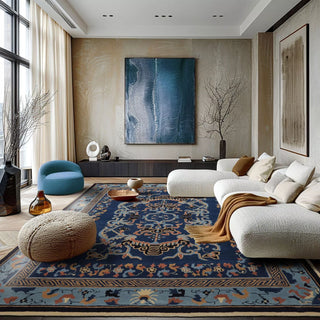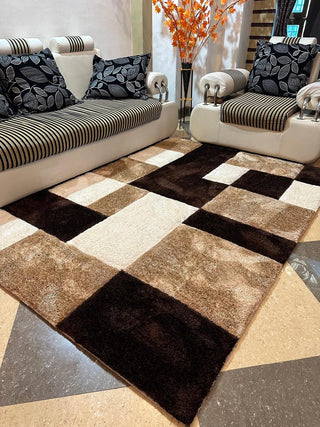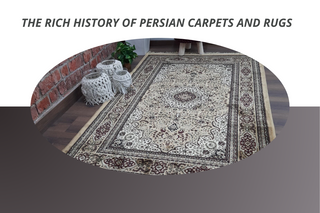Handmade Persian and Oriental rugs have been at the top of decor choices for everyone for centuries. Their intricate designs and vibrant colors depict a beautiful saga of Persian touch.
Despite cut-throat competition from machine-made rugs, hand-woven Persian and Oriental rugs remain sought-after in the luxury market as a premium choice to buy carpet online due to their artistry and craftsmanship.
Whether you’re looking to buy carpet online for your commercial or residential space, the choice to buy Persian carpet has been common for every buyer for ages. Moreover, these rugs are not just floor coverings; they're pedestals of Persian art and heritage.
In this comprehensive guide, we delve into the rich history of Persian carpets and rugs, tracing their evolution through different cultures and dynasties.
Ancient Weaving Techniques and Materials
If you’re looking to buy Persian carpet online and are excited about their historical past, then it is important to understand that this art of rug making is shrouded in mystery. While historical texts, like those of Xenophon, refer to the opulence and diplomatic importance of Persian carpets, the exact methods of their creation remain elusive. Whether they were pile-woven or crafted using alternative techniques such as flat-weaving or embroidery/textile remains a subject of intrigue.
What we do know is that ancient Persian weavers demonstrated remarkable resourcefulness. They employed materials like bamboo, plant stalks, and wool fibers to fashion intricate patterns and designs that still captivate today.
Significance of Rugs in Ancient Persian Society and Culture
Just as people buy Persian carpet online nowadays, the textile industry of ancient Persian society and culture was certainly a profitable business. Beyond serving diverse applications such as mere floor coverings, they symbolized prestige, luxury, and diplomacy. Accounts from Xenophon underscore the value of Persian carpets as diplomatic gifts, highlighting their opulent and prestigious nature.
As Persian society progressed, these rugs transcended their utilitarian purpose to become integral elements of the region's cultural and artistic identity. They epitomized the craftsmanship and artistry of the Persian people, showcasing their mastery of weaving techniques and their keen aesthetic sensibilities.
For those considering adding a touch of timeless elegance to their abode, exploring the rich heritage of Persian carpets offers a journey into exquisite craftsmanship and cultural depth. Whether you seek to buy Persian carpets online or simply wish to appreciate their historical significance, these masterpieces continue to enchant and inspire.
Early Influences: From Persia to the World
The Achaemenid Empire marked the early flourishing of Persian rugs, laying the groundwork for the intricate patterns and exquisite craftsmanship that define these carpets. Meanwhile, in ancient China and Central Asia, distinct rug-making traditions emerged, influenced by nomadic tribes and cultural exchange along the Silk Road.
The Islamic Golden Age: A Renaissance of Rug-Making
During the Islamic Golden Age, rug-making reached new heights of sophistication. Islamic artisans experimented with weaving techniques and designs, giving rise to intricate motifs like geometric patterns and calligraphic inscriptions. The spread of Islamic culture facilitated the exchange of rug-making knowledge across the Middle East, enriching the craft further.
The Glorious Safavid Dynasty: Masters of the Loom
The Safavid Dynasty ushered in a golden age of Persian rug-making. With patronage from rulers like Shah Abbas I, cities like Kerman and Kashan became epicenters of rug production. The Ardabil Carpet and the Sheikh Safi Carpet stand as timeless examples of Safavid artistry and innovation.
Ottoman Opulence: Turkish Rug Heritage
The Ottoman Empire left an indelible mark on rug production, with centers like Usak and Bergama gaining renown for their unique designs. Ottoman rugs, characterized by vibrant colors and distinctive motifs, reflect the empire's cultural richness and artistic prowess.
Mughal Magnificence: Indian Rug Renaissance
Under Mughal patronage, Indian rug-making flourished, blending Persian influences with local aesthetics. Cities like Agra and Jaipur became synonymous with exquisite rug craftsmanship, producing masterpieces adorned with intricate floral patterns and motifs.
Chinese Grandeur: The Qing Dynasty Legacy
The Qing Dynasty elevated Chinese rug-making to new heights, with centers like Beijing and Xinjiang producing rugs of unparalleled beauty and quality. These rugs, adorned with auspicious symbols and intricate designs, reflect China's rich cultural heritage.
Modern Expressions: Rug-Making in the Contemporary Era
In the 20th and 21st centuries, European art movements reshaped rug design, ushering in a new era of experimentation and innovation. Art Deco, Bauhaus, and Art Nouveau influences brought abstract forms and minimalist compositions to the forefront, shaping the contemporary rug landscape.
Final words
As we reflect on the rich history of Persian carpets and rugs, it's evident that these timeless artworks were common to higher demands like we buy carpet online in this modern age.
Coming to the thin line – Nomadic tribes in Central Asia ingeniously crafted durable floor coverings using twisted wool fibers, reflecting their pragmatic needs and artistic sensibilities. As Islam flourished in the 8th century, the Azerbaijan province emerged as a global epicenter for Persian carpet production. Here, weaving looms hummed alongside dye centers, birthing a thriving industry that endured until the Mongol invasion of Persia.
Today, Persian carpet sellers in India such as Carpet Planet stand as an authentic brand name pioneering the legacy of Persian history worldwide.



